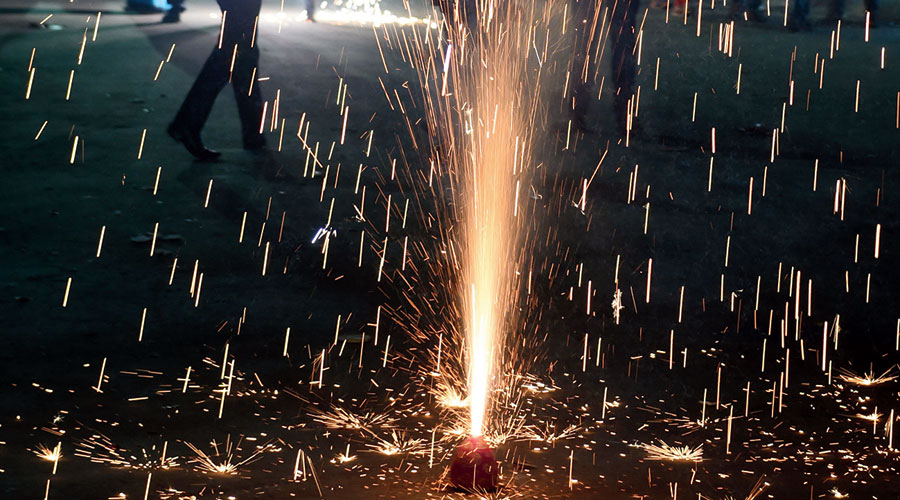
Diwali: Mix not Covid and crackers -cool mid-November air, will trap the pollutants close to the ground for long
The effect of the toxic particulates and fume will be many times more this Diwali because it falls on November 14
The cool mid-November air, environmentalists say, will trap the pollutants close to the ground for long.
Jayanta Basu | TT | Calcutta | 04.11.20 : The combination of deadly dust and smoke released by fireworks is extremely harmful to those suffering from Covid or have recovered from the disease, doctors and environmentalists say. The effect of the toxic particulates and fume will be many times more this Diwali because it falls on November 14. The cool mid-November air, environmentalists say, will trap the pollutants close to the ground for long.
Metro spoke to experts to assess the impending danger.
How do fireworks add to air pollution?
The major gases released by fireworks are sulphur dioxide, various oxides of nitrogen, carbon monoxide and carbon dioxide. All of them pollute the air we breathe.
“Oxides and compounds of many toxic heavy metals like copper, vanadium, cobalt, iron, cadmium and aluminum, released by fireworks, become part of particulate composition, both PM10 and PM2.5, in the air,” said Siddhartha Datta, a retired professor of chemical engineering at Jadavpur University.
PM10 and PM2.5 are fine particulates that enter deep into the lungs and trigger a host of critical ailments, including cancer.
How can a late Diwali add to the problem?
Diwali this year will be celebrated long after the withdrawal of the monsoon. The withdrawal facilitates the arrival of the northwesterly wind.
“Compared with Diwali in October, a mid-November Diwali will definitely be drier and cooler unless a major weather system develops in between,” said G.K. Das, regional director of IMD Calcutta.
A drop in temperature will lead to a phenomenon called thermal inversion, which will cause pollutant-rich cool air to remain close to the surface. “Such a trend, coupled with near-stagnant air as found during the period, leads to a situation where most of us will be forced to remain in a highly polluted air bubble. Burning of fireworks enhances the toxicity of such a bubble,” said Datta.
Such polluting columns, he said, may grow to about 60 feet.
How enhanced air pollution will impact Covid patients?
“While sulphur dioxide directly irritates the respiratory system, oxides of nitrogen increase oxidative stress and affect the protective mucosal layer of the lungs, magnifying the risk of attack from viruses like SARS-CoV-2,” said pulmonologist Arup Haldar.
“Enhanced pollution is deadly not only for Covid patients, whose lungs are compromised, but also those who have recovered from the disease,” said pulmonologist Alok Gopal Ghosal.
Ghosal pointed out that Covid patients, after being cured of infection, are taking long to recover from respiratory ailments. Exposure to increased pollution will only worsen the situation.“Even without Covid, according to the latest global report, almost one out of every four global air pollution deaths occurs in India. The Diwali pollution during the pandemic will add to the vulnerability,” said Anumita Roy Choudhury, an air pollution expert from the Centre for Science and Environment (CSE).
Who are the most vulnerable?
Just about anyone. Covid patients and those who have recovered from the coronavirus disease are more vulnerable. It would be worse for the elderly.

0 Response to "Diwali: Mix not Covid and crackers -cool mid-November air, will trap the pollutants close to the ground for long"
Post a Comment
Disclaimer Note:
The views expressed in the articles published here are solely those of the author and do not necessarily reflect the official policy, position, or perspective of Kalimpong News or KalimNews. Kalimpong News and KalimNews disclaim all liability for the published or posted articles, news, and information and assume no responsibility for the accuracy or validity of the content.
Kalimpong News is a non-profit online news platform managed by KalimNews and operated under the Kalimpong Press Club.
Comment Policy:
We encourage respectful and constructive discussions. Please ensure decency while commenting and register with your email ID to participate.
Note: only a member of this blog may post a comment.